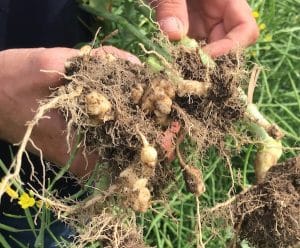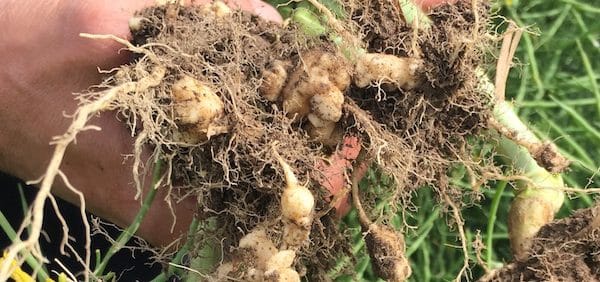The first step in managing clubroot is to minimize the chance of introducing clubroot to the farm in the first place. Make sure equipment and vehicles entering fields are clean. (Link to disinfection tips.) All people entering a field should have disinfected rubber boots or wear disposable booties over their footwear. All seed (not just canola) should be cleaned and treated to prevent introduction of clubroot on dirt tag.

If clubroot is present in a field, then take measures to prevent the build-up of spores to limit yield loss in future canola fields. To prevent the build up:
1. Deploy a clubroot-resistant (CR) variety as early as possible. Certainly do this when clubroot is confirmed on your farm (either through plant symptoms or soil DNA test), but CR varieties are also recommended when clubroot is confirmed or even suspected in your community or region.
2. Control weeds/volunteer canola, as these can promote spore build up in non-canola years in the rotation.
3. Rotate out of canola for at least 2 years.
4. Prevent the movement of spores within the field so patches are contained as long as possible. To do this, reduce tillage, designate field entrances and exits and isolate affected areas.
4 (i). More on field entrances and exits. Given that 90% of fields identified with clubroot show symptoms at field entrances first and that these areas tend to be the most heavily infested, having a separate exit means equipment isn’t leaving from the most infested area of the field and picking up spores on the way out.
4 (ii). More on isolating affected areas. Liming to increase pH can help reduce clubroot severity, although research has not yet determined how much to apply. Another option is to seed the patch to a non-host perennial such as perennial ryegrass to stop soil movement. While a patch left for five years or more will greatly reduce the viable spores left within this patch, it may not eliminate the risk entirely.
5. Scout for signs that clubroot has spread to other patches or other fields. If scouting suggests that CR varieties seem to be losing their resistance to clubroot pathotypes within a field, rotate to a different source of resistance or extend the length of the canola rotation.
6. Keep informed. Read the detailed content at clubroot.ca and listen to local agronomy and extension people.
